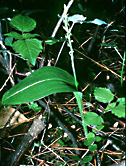Malaxis monophyllos (L.) Sw. var. brachypoda (Gray) Morris
& Eames
White adder's mouth
The specific epithet monophyllos is from the Greek meaning "single
leaf" and the varietal name brachypoda is from the Greek meaning
"short foot," apparently in reference to the length of the pedicels.

Photo courtesy of Ken Sytsma
DESCRIPTION: Plant glabrous, 10-20
cm tall, arising from an cluster of slender roots; base of the stem swollen
to form a pseudobulb. Leaf solitary, located above the base of the
stem, but with a sheathing base that reaches base of stem, ovate-elliptical,
3-10 cm long and 2-5 cm wide. Midrib prominent, forming a keel below. Inflorescence
a loose, elongate raceme of greenish-white flowers, spicate, 15-50 flowered;
each flower subtended by a minute lanceolate bract. Sepals lanceolate
to ovate-lanceolate, 1.5-2.5 mm long and about 1-2 mm wide, green to greenish
white. Petals linear, 1.5-2 mm long and about 0.5 mm wide and colored
as the sepals; typically reflexed back along the ovary. Labellum
not resupinate, cordate, the apex drawn out into an acute point and typically
with two basal lobes of tissue that project forward, 1-2 mm long and 1-2
mm wide (at widest point), colored as sepals and petals.
SIMILAR SPECIES: Malaxis monophyllos could possibly be confused
with M. unifolia; however, the elongate
inflorescence of M. monophyllos is distinctly different from the
capitate inflorescence of M. unifolia.
In addition, the three-toothed labellum of M.
unifolia is easily distinguished from the acute labellum of M.
monophyllos. In fruit, these taxa can be separated by the length of
the pedicels: the pedicels are shorter than the ovaries in M. monophyllos
and longer than the ovaries in M. unifolia.
Malaxis monophyllos could also possibly be confused with several
species of Listera; however, all species
of Listera have two leaves, rather than
the single leaf of Malaxis.
HABITAT: The typical habitat for Malaxis monophyllos in Wisconsin
is in bogs on mats of Sphagnum, underneath a canopy of Thuja
or Abies.
FLOWERING DATES: June 20-August 1.
POLLINATION: Unknown. Based on the small size of the flowers and their
color and habitat, I would expect that pollination might be by fungus gnats.
WI DISTRIBUTION:  U.S. DISTRIBUTION:
U.S. DISTRIBUTION:
Go directly to Wisconsin herbarium
records.
Return to the main LIST of
the Orchids of Wisconsin.
Return to the main KEY to the Orchids of
Wisconsin.

 U.S. DISTRIBUTION:
U.S. DISTRIBUTION: